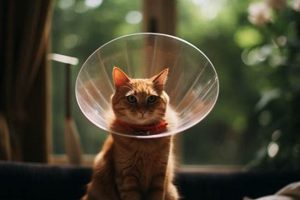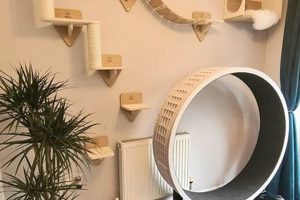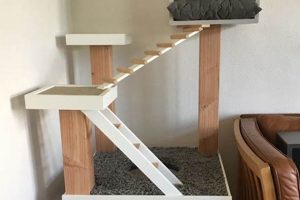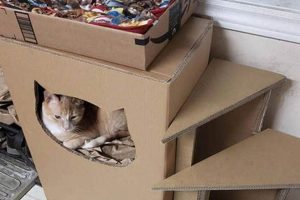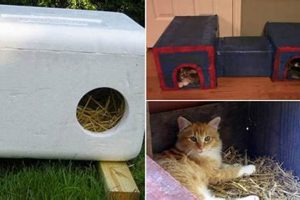Construction of secure, enclosed spaces that allow domestic felines access to the outdoors using primarily self-provided labor and materials characterizes a specific project type. An example includes building a mesh-enclosed tunnel extending from a window to a freestanding enclosure, providing safe external access for a pet. This approach contrasts with purchasing pre-fabricated commercial products.
The appeal of these projects stems from several factors, including enhanced feline well-being through access to natural stimuli, owner cost savings, and customized designs suited to individual property constraints and aesthetic preferences. Historically, securing domestic animals has been a concern for both animal safety and the mitigation of negative impacts on local wildlife; this represents a modern iteration of addressing these concerns.
The following sections will detail key considerations in the planning and execution of such projects, including material selection, structural integrity, environmental safety, and feline enrichment strategies to ensure the long-term success and usability of the structure.
Essential Considerations for Construction
The successful creation of a secure outdoor space for felines hinges on meticulous planning and diligent execution. Attention to detail is paramount to ensure the structure provides both enrichment and safety for the animal.
Tip 1: Secure Perimeter Establishment: Prioritize a fully enclosed structure, extending either below ground or incorporating anti-digging barriers. This prevents escape and protects against intrusion by other animals.
Tip 2: Material Selection for Durability: Opt for weather-resistant materials such as treated lumber, galvanized wire mesh, or durable polycarbonate roofing. These choices contribute to longevity and minimize maintenance.
Tip 3: Vertical Space Optimization: Incorporate elevated platforms, climbing structures, and scratching posts. These additions cater to a feline’s natural instincts and promote physical activity.
Tip 4: Environmental Safety Protocols: Ensure all materials are non-toxic and free from sharp edges or potential hazards. Consider shading to prevent overheating during warmer months.
Tip 5: Gradual Introduction Process: Acclimatize the feline to the structure slowly, using positive reinforcement techniques. This fosters comfort and reduces anxiety associated with a new environment.
Tip 6: Regular Maintenance Schedule: Establish a routine inspection process to identify and address potential structural weaknesses or safety concerns. This proactive approach helps prevent accidents and extend the life of the structure.
Tip 7: Legal Compliance Verification: Investigate local ordinances and homeowner association regulations regarding pet enclosures. Ensure the structure complies with all applicable requirements to avoid potential legal issues.
Implementing these measures significantly enhances the safety, functionality, and enjoyment derived from the constructed space. The result is an enriching environment for the animal and peace of mind for the owner.
The subsequent section will address advanced design considerations, including integration with existing landscaping and features that cater to specific feline behavioral needs.
1. Secure Enclosure
The concept of a secure enclosure is fundamental to the successful implementation of any self-constructed outdoor space for felines. Its primary function is to provide a safe environment, preventing escapes and protecting the animal from external threats. The integrity of the enclosure directly impacts the well-being of the cat and the peace of mind of the owner.
- Perimeter Security
The perimeter constitutes the first line of defense. It must be constructed to prevent digging under or climbing over. Examples include burying wire mesh below ground level, using solid walls, or incorporating an overhang to deter climbing. Failure to adequately secure the perimeter compromises the entire structure.
- Material Strength and Durability
The selected materials must withstand environmental factors and the force exerted by the animal. Lightweight or easily damaged materials are unsuitable. Robust options, such as treated lumber and heavy-gauge wire mesh, provide necessary resistance. The longevity of the enclosure is directly tied to the quality of materials used.
- Access Point Security
Doors and gates represent potential weak points in the enclosure. They must feature secure latches or locking mechanisms that cannot be easily manipulated by the animal or compromised by external forces. Regular inspection and maintenance of these access points are crucial.
- Integration with Existing Structures
When connecting the enclosure to a house or other building, the connection point must be equally secure. Tunnels or passageways should be fully enclosed and constructed of durable materials. Gaps or openings can undermine the security of the entire system.
These interconnected facets of a secure enclosure are crucial for the overall success. Prioritizing these considerations ensures the enclosure fulfills its intended purpose: providing a safe and enriching outdoor environment for the feline without risk of escape or exposure to external dangers. Neglecting any of these aspects can result in significant risks and compromise the integrity of the project.
2. Durable Materials
The longevity and safety of a self-constructed outdoor feline enclosure are directly correlated with the selection of durable materials. Inferior materials degrade rapidly under exposure to environmental elements, compromising the structural integrity of the enclosure and potentially endangering the animal. The use of weather-resistant lumber, galvanized steel mesh, and UV-resistant polycarbonate roofing exemplifies material choices that contribute to extended lifespan and reduced maintenance requirements. Conversely, untreated wood, low-gauge chicken wire, or non-UV stabilized plastics will exhibit premature failure, necessitating costly repairs or complete reconstruction.
The implementation of durable materials also has practical implications for animal safety. Rusted or corroded wire mesh presents a laceration hazard. Deteriorated lumber can splinter, causing injury. The selection of materials must, therefore, prioritize both resistance to environmental degradation and non-toxicity. Pressure-treated lumber, for example, should be carefully evaluated to ensure it meets established safety standards for animal contact. Furthermore, durable materials reduce the risk of escape. Stronger materials resist clawing, chewing, and impacts from external forces, maintaining the integrity of the enclosure and preventing breaches that could allow the animal to escape or predators to enter.
In conclusion, the specification of durable materials is not merely a matter of cost-effectiveness but a fundamental aspect of responsible construction. It ensures the safety and well-being of the enclosed animal, reduces long-term maintenance expenses, and minimizes the risk of structural failure. The investment in quality materials at the outset translates to a more secure, reliable, and enduring outdoor environment for the feline.
3. Environmental Safety
The intersection of environmental safety and self-constructed outdoor enclosures for felines represents a critical consideration in responsible pet ownership and ecological stewardship. The materials used, the structure’s design, and its interaction with the surrounding environment can have significant consequences for the feline’s health and the local ecosystem. Prioritizing environmental safety mitigates potential risks associated with toxic materials, habitat disruption, and unintended impacts on native wildlife.
A key aspect of environmental safety lies in the careful selection of non-toxic building materials. Treated lumber, while often used for its weather resistance, can contain chemicals harmful to animals if ingested or through prolonged contact. Opting for untreated wood or lumber treated with animal-safe preservatives is essential. Similarly, paints and sealants must be chosen with consideration for their volatile organic compound (VOC) content, as off-gassing can pose a respiratory hazard to the feline. The enclosure’s design must also minimize the risk of injury from sharp edges, protruding nails, or unstable surfaces. Furthermore, if the enclosure incorporates plants, it is vital to select non-toxic species to prevent accidental poisoning. Consider, for example, the replacement of oleander, a toxic ornamental shrub, with cat-friendly alternatives like catmint or cat grass.
The responsible construction of a feline enclosure also extends to minimizing its impact on the surrounding environment. Site selection should avoid disturbing sensitive habitats or disrupting existing wildlife corridors. The enclosure should be designed to prevent the feline from preying on native birds or small mammals. This can be achieved through the use of fine-mesh netting and ensuring the enclosure is fully enclosed, including the top. Furthermore, waste management within the enclosure is crucial. Regular cleaning and proper disposal of feline waste prevent the spread of parasites and diseases. In summary, integrating environmental safety considerations into every stage of design and construction ensures a harmonious relationship between the feline, its enclosure, and the surrounding ecosystem.
4. Feline Enrichment
The construction of outdoor enclosures for domestic felines provides an avenue for environmental enrichment, a critical component for their physical and psychological well-being. Confinement within a domestic environment, while providing safety and sustenance, can limit opportunities for natural behaviors such as hunting, exploration, and social interaction. An appropriately designed outdoor enclosure addresses these limitations by expanding the feline’s sensory and motor experiences. The inclusion of vertical spaces, scratching posts, and interactive toys within the enclosure directly stimulates natural instincts, mitigating boredom and reducing the likelihood of behavioral problems associated with prolonged inactivity.
The design elements of the enclosure directly influence the degree of environmental enrichment achieved. Consider, for example, the inclusion of natural substrates such as grass or wood chips. These provide tactile stimulation and opportunities for digging and exploration. Strategically placed feeding stations encourage foraging behaviors, while elevated perches offer vantage points for observation, satisfying the feline’s predatory instincts. Furthermore, the integration of interactive elements, such as puzzle feeders or toys that mimic prey, promotes cognitive stimulation and reduces the risk of cognitive decline. The size and complexity of the enclosure must be tailored to the individual feline’s needs and temperament, ensuring that the environment remains stimulating without being overwhelming. Failure to adequately address enrichment needs within the enclosure can result in apathy, anxiety, or the manifestation of undesirable behaviors such as excessive grooming or destructive scratching.
In summary, the successful integration of environmental enrichment principles into the design and construction of outdoor feline enclosures is paramount. By providing opportunities for natural behaviors and stimulating the feline’s senses, these enclosures promote both physical and psychological well-being. The benefits extend beyond the individual animal, contributing to a more harmonious relationship between the feline, its environment, and its human caregivers. Ignoring this crucial element undermines the purpose of the enclosure and may ultimately detract from the feline’s overall quality of life.
5. Structural Integrity
Structural integrity is a foundational element for any self-constructed outdoor enclosure intended for domestic felines. Its presence ensures the longevity, safety, and usability of the space. Deficiencies in structural design or execution directly compromise the enclosure’s ability to contain the animal securely and protect it from external hazards. For instance, a frame constructed from improperly joined lumber is susceptible to collapse, potentially injuring the feline or allowing escape. Similarly, inadequate anchoring of the enclosure to the ground can render it vulnerable to wind damage or overturning, particularly in regions prone to inclement weather. The correlation between sound construction principles and a functional, lasting structure is direct and undeniable.
The choice of materials significantly influences structural integrity. Employing pressure-treated lumber, galvanized steel mesh, and durable roofing materials contributes to resistance against environmental degradation. Conversely, using untreated wood or lightweight wire mesh compromises the structural integrity, leading to premature failure. Consider the case of an enclosure built with chicken wire, a material easily breached by larger animals or through persistent clawing. This not only creates an escape risk but also exposes the feline to potential predators. Proper load-bearing calculations, secure fastening methods, and reinforcement of weak points are essential practices that contribute to the overall structural stability. The selection process needs to account for potential stressors, including snow load, wind resistance, and the active movements of the animal within the enclosure.
In summary, structural integrity is not merely a construction detail; it is a critical determinant of the enclosure’s success. Its absence results in a heightened risk of animal escape, injury, or exposure to external threats. A proactive approach to structural design, material selection, and construction techniques is paramount. This involves adherence to established building principles, thorough assessment of potential stressors, and a commitment to quality craftsmanship. The result is a safe, durable, and functional outdoor space that enhances the feline’s well-being and provides peace of mind to the owner. This aspect requires serious consideration and proper planning to achieve the best and safest result from an outdoor project.
6. Weather Protection
The implementation of effective weather protection is paramount to the successful and humane creation of outdoor enclosures for domestic felines. It directly impacts the usability of the structure, the health of the animal, and the long-term viability of the project. Insufficient protection from the elements renders the enclosure unusable during inclement weather and exposes the feline to potential health risks associated with extreme temperatures, precipitation, and excessive sunlight.
- Roofing Materials and Design
The selection of roofing materials and the design of the roof itself are critical components of weather protection. Solid roofing, such as polycarbonate panels or asphalt shingles, provides comprehensive shelter from rain, snow, and direct sunlight. A sloped roof facilitates water runoff and prevents the accumulation of snow, minimizing the risk of structural damage. Partial roofing, utilizing shade cloth or lattice, offers filtered sunlight and ventilation during warmer months. The specific choice depends on the prevailing climate and the feline’s sensitivity to sunlight.
- Wind Barriers and Draft Reduction
Exposure to strong winds can create a hazardous environment within the enclosure, particularly during colder months. The strategic placement of wind barriers, such as solid panels or tightly woven mesh, minimizes drafts and prevents the accumulation of snow within the enclosure. Consideration must be given to maintaining adequate ventilation to prevent the buildup of moisture and condensation. Overly restrictive wind barriers can lead to stagnant air and increased humidity, creating an unfavorable environment for the feline.
- Ground Cover and Drainage
The type of ground cover and the presence of adequate drainage systems significantly impact the enclosure’s habitability during wet weather. Porous materials, such as gravel or wood chips, facilitate water drainage and prevent the formation of mud. Impermeable surfaces, such as concrete, require drainage slopes or channels to direct water away from the enclosure. Proper drainage minimizes the risk of fungal growth, insect infestations, and the accumulation of standing water, which can pose health risks to the feline.
- Seasonal Adaptations
Effective weather protection necessitates seasonal adaptations to address the changing environmental conditions. In colder climates, the addition of heated shelters or insulated bedding provides warmth and comfort during winter months. During warmer months, the provision of shade and access to fresh water prevents overheating and dehydration. These adaptations ensure the enclosure remains a safe and comfortable environment for the feline year-round.
These interconnected aspects of weather protection are essential for the responsible and ethical creation of outdoor feline enclosures. Neglecting these considerations compromises the animal’s well-being and reduces the long-term usability of the structure. Implementing effective weather protection strategies is, therefore, a fundamental component of any self-directed outdoor project.
Frequently Asked Questions
The following addresses common inquiries regarding the self-directed construction of outdoor enclosures for domestic felines, clarifying critical considerations for design, construction, and maintenance.
Question 1: What is the minimum recommended size for an enclosure intended for a single feline?
The absolute minimum should allow the cat to fully stretch, climb, and move around freely. A floor area of at least 24 square feet and a height of 6 feet is generally advised. Larger enclosures are, of course, beneficial.
Question 2: How frequently should a constructed outdoor space be cleaned and maintained?
Daily spot cleaning of waste is necessary. A thorough cleaning, including disinfection of surfaces, should be conducted weekly. Regular inspection for structural damage is also recommended.
Question 3: What are the key considerations when introducing a feline to a new enclosure?
Gradual acclimatization is essential. Initially, the cat should be allowed only brief, supervised visits. Positive reinforcement, such as treats or toys, can encourage exploration. The space should contain familiar scents and objects.
Question 4: How can an individual ensure the chosen construction materials are safe for feline contact?
Materials should be non-toxic and free of sharp edges or splinters. Pressure-treated lumber requires careful evaluation to ensure animal safety. Research and verification of material composition are essential.
Question 5: What methods can be employed to protect an enclosure from potential predators?
A secure perimeter, extending below ground or incorporating anti-digging barriers, is critical. Heavy-gauge wire mesh and robust framing materials are also necessary. Motion-activated deterrents may offer additional protection.
Question 6: How can the temperature within an enclosure be regulated during extreme weather?
Shade structures, such as roofs or shade cloth, can mitigate heat exposure. In colder climates, insulated shelters or heated pads can provide warmth. Adequate ventilation is essential to prevent overheating.
These answers offer fundamental guidance for those embarking on this project. Careful planning and execution are critical for success.
The subsequent section will focus on advanced design concepts, incorporating elements that cater to specific feline behaviors and environmental preferences.
Conclusion
The self-directed creation of outdoor enclosures for felines represents a multifaceted undertaking demanding meticulous planning and diligent execution. As previously detailed, factors such as structural integrity, material safety, environmental considerations, and enrichment strategies must be carefully weighed to ensure a successful outcome. Compromising on any of these aspects introduces potential risks to the animal’s well-being and the longevity of the structure itself.
Therefore, approaching the creation of an outdoor feline enclosure necessitates a commitment to thorough research, responsible material selection, and adherence to sound construction principles. This dedication not only fosters a safe and stimulating environment for the animal but also underscores the owner’s commitment to responsible pet ownership and environmental stewardship. The long-term benefits of a well-executed project far outweigh the initial investment of time and resources.


